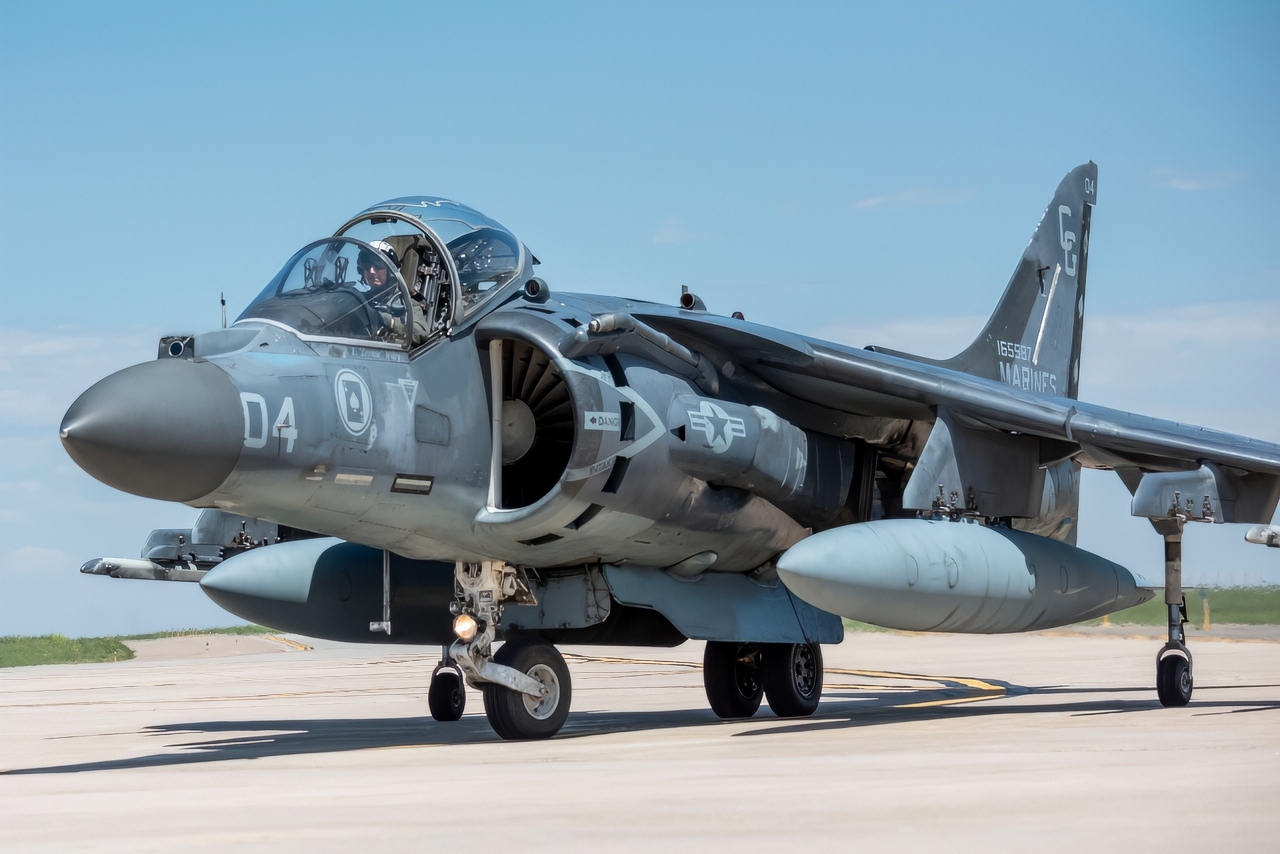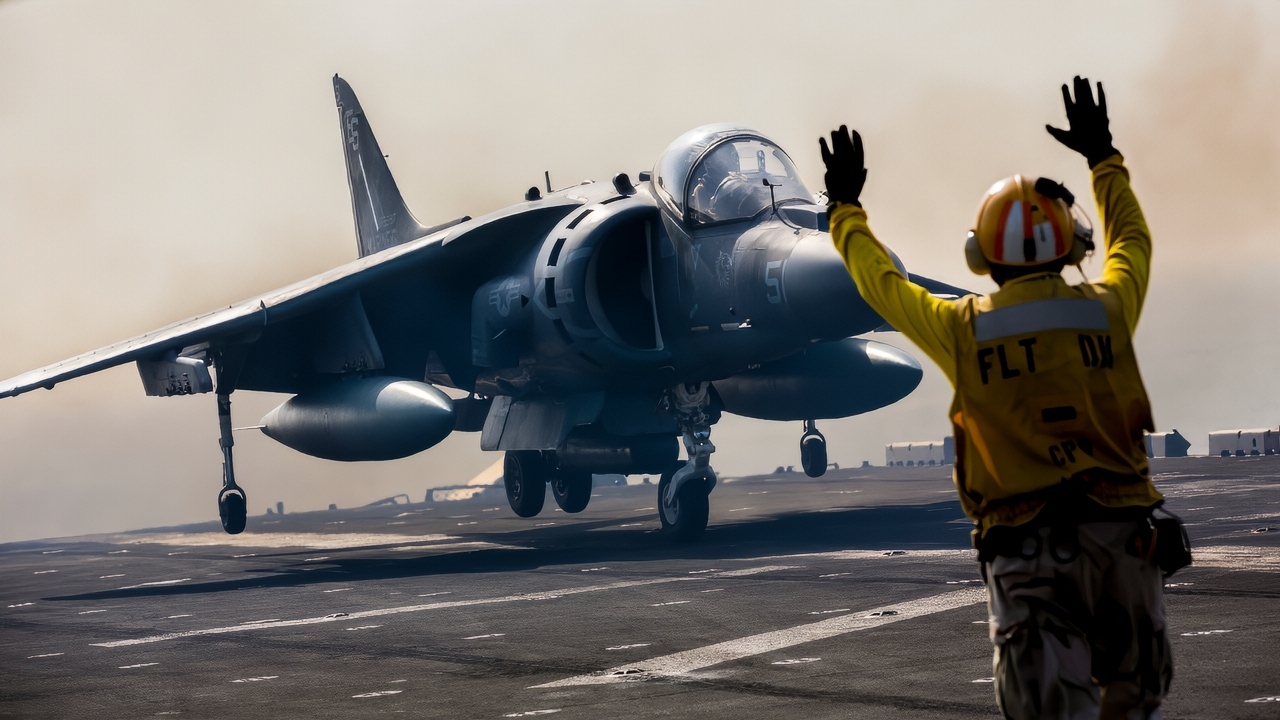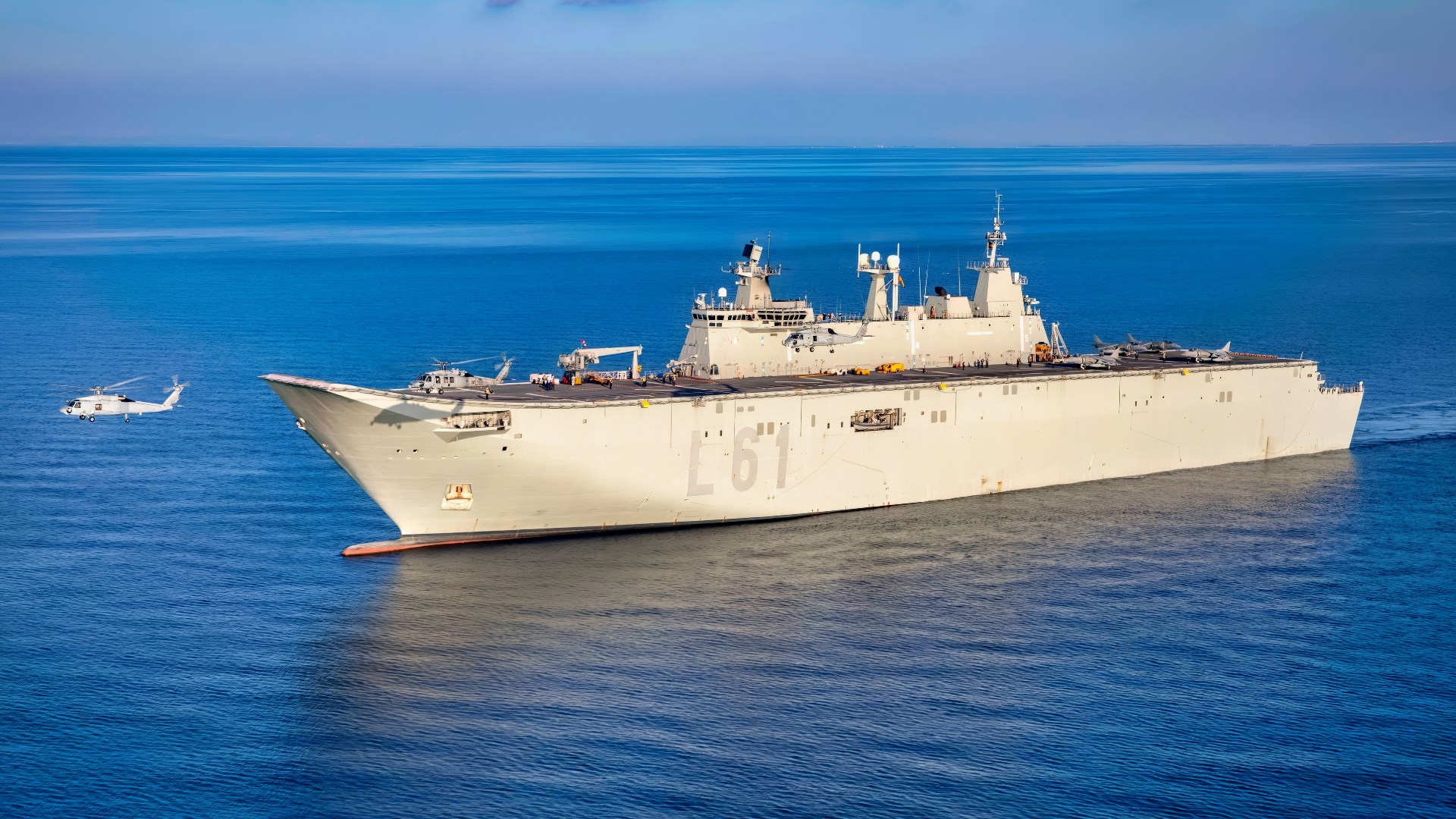Key Points and Summary – After losing access to the F-35B stealth fighter, Spain and Turkey are pragmatically adapting their ski-jump equipped light aircraft carriers for unmanned drone operations.
-Turkey, ejected from the F-35 program, is now fielding the Bayraktar TB3 armed drone on its carrier, the TCG Anadolu.
-Spain, which recently withdrew from F-35B procurement, is pursuing the Airbus SIRTAP reconnaissance drone for its Juan Carlos I.
-This pivot to unmanned naval aviation, born of necessity, showcases a new and innovative, if less capable, path forward for carrier airpower.
Spain’s Juan Carlos I Amphibious Assault Ship was an Export Success
No longer parties to the American-led F-35 stealth fighter program, the Spanish and Turkish navies have had to adjust their naval aviation operations, opting instead to launch and recover unmanned drones in lieu of manned stealth fighters.
The Juan Carlos I amphibious assault ship serves in the Spanish Navy in a similar capacity to what could be dubbed a light aircraft carrier.
The Spanish Navy originally ordered the ship back in 2004. It is the biggest warship ever built for the Spanish Navy, and was designated for operations with short take-off and vertical landing aircraft like the V-8B+ Harrier II, a Cold War-era STOVL aircraft.
It can also operate with helicopters.
Unlike dedicated aircraft carriers in the American Navy, like the outgoing Nimitz-class aircraft carriers, or the upcoming Gerald R. Ford-class of supercarriers (both classes are nuclear-powered), the Juan Carlos I can launch and recover landing craft and Assault Amphibious Vehicles thanks to its large well deck.
However, the Spanish ship is conventionally, rather than nuclear-powered.
In 2023, the Spanish Navy inked a deal with Navantia, a Spanish state-owned shipbuilder, to upgrade the Juan Carlos I with an electric propulsion system, a pair of ABB Azipod pods, which are anticipated to boost the ship’s maneuverability in tight spaces like littoral waters as well as at port and when maneuvering alongside other vessels.
The Royal Australian Navy also operates a variant of the Spanish platform, with a pair of Canberra-class landing helicopter docks in service.
A Shift to Drone Operations from Sea: the Spanish and Turkish Navies
Both the Turks and the Spanish are adapting their naval operations to accommodate carrier-capable drones. Both the Juan Carlos I and the closely related Turkish derivative of that ship, the Turkish Navy’s TCG Anadolu, feature prominent ski jumps that allow aircraft to take off from shorter platforms.
Both countries are leveraging this design consideration for use with navalized drones.
The Turks opted to retain the original design’s ski jump flight deck when it inked a deal with
Spain is considering Turkey’s planned purchase of F-35B short-takeoff and vertical-landing stealth fighters.
However, Turkey had been a Level 3 partner in the F-35 program.
Following Turkey’s purchase of the Russian S-400 air defense system, however, the United States stripped Turkey from the program, citing the danger posed to the stealth fighter by the advanced Russian air defense batteries.
Frozen out of the F-35 program, Turkey has adjusted, developing the TB3, a navalized version of the Bayraktar TB2 drone.
In addition to folding wings and reinforced landing gear, the TB3 program conducted landing trials on the TCG Anadolu in 2024.
The TB3 can easily take off from the Juan Carlos I-derived ski jump, which is sloped at 12 degrees, and can also land without the use of arrestor cables to “catch” and slow the drone, thanks in part to its smaller size and lower weight compared to manned aircraft.
Spain is also preparing for unmanned operations from the Juan Carlos I. Instead of refitting the carrier with arrestor cabling and catapults, the Spanish Navy, like the Turks, is adapting to unmanned carrier operations through the SIRTAP program.
“Developed as a high-end tactical UAS, SIRTAP will provide unrivaled performance superiority for surveillance thanks to its ability to simultaneously integrate two payloads, such as an electro-optical turret and a multi-mission radar,” aerospace firm Airbus explains.
“SIRTAP will provide this leap in performance in the high-end tactical UAS segment. Its defence and security applications will offer a wide range of missions tailored to the operational needs of customers in both the institutional and governmental markets.
Designed to fly in the harshest environmental and operational conditions, the UAS will be certified by the Spanish Military Airworthiness Authorities to fly in segregated airspace.”
But unlike the TB3 that the Turkish Navy intended to fly off its TCG Anadolu, Spain’s SIRTAP drone has a modest 400-pound mission payload. Although it boasts a respectable 20-hour endurance, it is primarily a reconnaissance drone and lacks the ability — for now at least — to fly armed.
The Spanish decision, like Turkey’s, is driven by pragmatism.
Following Madrid’s abrupt decision to withdraw from F-35B purchases earlier this year, the country has had to grapple with what platform follows its Harrier jump jets.

An AV-8B Harrier aircraft, known for its vertical/short takeoff and landing capabilities, utilizes the airfield at the 140th Wing, Buckley Space Force Base, Aurora, Colorado June 10, 2025. Piloted by U.S. Marine Corps Capt. Ryan Gettinger, the aircraft was demilitarized and delivered to Wings Over the Rockies Air and Space Museum in Aurora. (Photo by U.S. Air National Guard Tech. Sgt. Chance Johnson)

A flight deck crewman directs the pilot of a U.S. Marine Corp AV-8B Harrier as it touches down on the flight deck of the USS Kearsarge (LHD 3) during flight operations at sea on Sept. 24, 2013. The Harrier is assigned to Marine Medium Tiltrotor Squadron 266 (Reinforced) and is embarked on board the Kearsarge as part of the 26th Marine Expeditionary Unit.
(DoD photo by Sgt. Christopher Q. Stone, U.S. Marine Corps. (Released))
But lacking any stealth capabilities, weapon loadout, or stealth characteristics, the SIRTAP makes a poor substitute for a fifth-generation carrier-capable fighter.
About the Author: Caleb Larson
Caleb Larson is an American multiformat journalist based in Berlin, Germany. His work covers the intersection of conflict and society, focusing on American foreign policy and European security. He has reported from Germany, Russia, and the United States. Most recently, he covered the war in Ukraine, reporting extensively on the war’s shifting battle lines from Donbas and writing on the war’s civilian and humanitarian toll. Previously, he worked as a Defense Reporter for POLITICO Europe. You can follow his latest work on X.
More Military
Army MV-75 Has a “Digital Backbone” to Stand Up to China in the Pacific
The F-35 Stealth Fighter Great Leap Forward Has Arrived
New Challenger 3 NATO Tank Is Built for Just 1 Mission It Can’t Fulfill
Sunk 10,000 Feet Down: A U.S. Navy Nuclear Submarine Was Lost, And No One Knows Why










